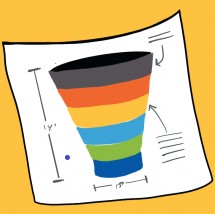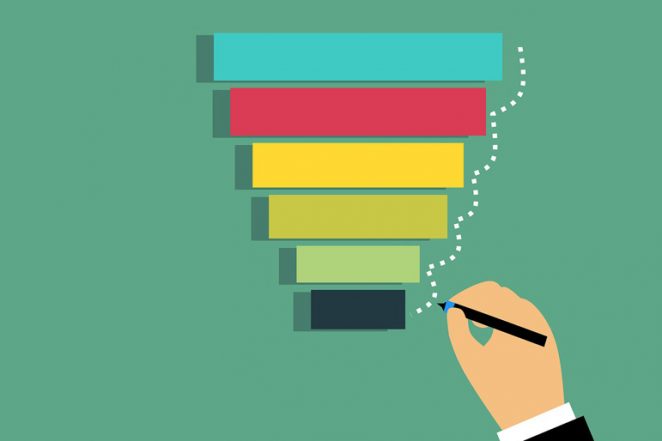What is a Sales Funnel? (A Beginner’s Guide for 2022)
Kris Freeman
Sales funnels are the road maps potential customers follow on their way to a sale.
Every stage along this path has a specific purpose, with the ultimate goal of moving your prospects seamlessly through each phase of the funnel.
Although every sales funnel is unique, you will find they all follow similar paths, and share the same underlying strategy.
And as a business owner, knowing the psychology of the sales funnel and how to optimize each stage of the process is crucial for developing a bulletproof marketing strategy.
So let’s jump in and learn the ins and outs of a sales funnel and how to build one for your business.
What is a Sales Funnel?

To buy or not to buy is a decision every consumer contemplates.
A sales funnel represents that journey and the steps a person takes before purchasing your product or service.
And just as the name implies, a sales funnel narrows down your target audience, which helps you focus on the ones who are the best fit for what you offer.
In a sales funnel, there are the following three main categories of prospects:
- Top of the funnel, which represents the broadest category of your potential prospects. For example, moms in their 50’s.
- Middle of the funnel, which is where your target audience starts to narrow further. For example, moms in their 50’s who are empty nesters.
- Bottom of the funnel, which is where you will find your perfect customers. For example, women in their 50’s who are empty nesters and looking for a career change.
Distilling prospects through a sales funnel aligns you with those you can serve the best, which saves you from a lot of guesswork.
As your target audience filters through your funnel, ideal prospects will become more apparent.
However, it’s essential to know that your potential customers experience sales funnels differently than sellers.
The following three phases represent a sales funnel from the buyer’s point of view:
- Awareness phase (Top-of-the-funnel): This is where the buyer is becoming aware of their problem and is interested in discovering different solutions.
- Consideration phase (Middle-of-the-funnel): Here, the buyer starts evaluating what solutions will best fit their needs.
- Decision phase (Bottom-of-the-funnel): In this phase, the buyer decides to become a customer and buy the product they think will solve their problems.
Understanding the perspectives of both buyers and sellers is essential if you want to create a sales funnel that effectively converts prospects into customers.
Why is a Sales Funnel Important?
Without a sales funnel, your overall marketing strategy can be hit or miss.
So let’s explore four major reasons why having a sales funnel is crucial for your business.
1. Allows You to Share the Right Message at the Right Time
When you create a sales funnel, you are intimately aware of your buyers’ needs at each stage.
Whether top, middle, or bottom, the sales funnel lets you know what messages to deliver based on the buyers’ position in the funnel.
So now, if you want to focus on marketing strategies that cater to the decision phase of your buyers’ journey, you will have the insight to deliver the proper messaging.
2. Assists in Turning Cold Leads To Warm Leads
A sales funnel helps you facilitate your buyer’s journey without alienating them or pushing them to do something they are not yet ready to do.
Because you know what your buyers are thinking in the different phases of the sales funnel, you can speak their language.
Speaking someone’s language cultivates trust and leads a buyer into feeling like someone cares.
Sure, they may not buy from you right away; however, you build a relationship that will move them closer to a sale.
3. Helps Create More Leads to Generate More Sales
A well-thought-out sales funnel may take some time to put together initially; however, it is an investment that will pay for itself many times over.
And with today’s technology, you can systematically automate the process online to capture those potential buyers on autopilot, ultimately translating to more profit for you.
This automation becomes a lead magnet for you to pull in a steady stream of buyers that moves them towards your desired outcome – sales.
4. Provides the Perfect Model for Business Growth
The sales funnel is hands down the best way for you to grow your business.
Why? Because it gives you real-time feedback based on the choices your buyers are making during the sales process.
This feedback is a gold mine of information that allows you to pivot your marketing messaging to more succinctly cater to your buyers’ needs.
When you actively have a pulse on your buyers’ needs and can accommodate them in a way that works, you establish a win-win relationship.
What are the Sales Funnel Stages?
An effective sales funnel consists of 4 distinct stages.

Stage 1: Awareness
The awareness stage is where a potential customer becomes aware of your business and its offerings.
Awareness comes through various channels, including a Facebook or blog post, landing on your website via a Google search, a promotion or business ad, and word of mouth.
At this stage of the funnel, consumers might become aware that they have a problem for the first time. And others may already be aware of the problem and are looking for solutions.
Educating your audience into knowing you have something that can really help and ultimately solve their predicament will move them into the next stage of the funnel quickly.
Stage 2: Interest
At this stage of the funnel, most of your consumers know that they have a problem they want to solve.
However, they may not focus on who provides that solution yet because they are still evaluating different options to remedy their problem.
For example, say a person experiencing back pain is unsure if they need a new mattress or a good chiropractor (or both) to give them the relief they want.
Keep in mind that this is the funnel stage where you educate your audience in more detail and take a deep dive into answering their questions and concerns.
Stage 3: Decision
At the decision stage, consumers are ready to decide whether or not to buy your product or service.
Your potential customers have done their homework and are looking for a suitable business to provide them with a solution that works.
In this funnel stage, you want to outshine your competition and make your potential customer an offer they cannot refuse.
Stage 4: Action
At the bottom of the sales funnel is where a prospect can become a customer. This is often viewed as the best part of the funnel because conversions happen here.
However, your job as a marketer or business owner does not end here. Your question to yourself should now be, “how do I turn this one sale into more?”
How do I create repeat business? How do I initiate word of mouth and brand loyalty?
Fortunately, you now have customers that can give you feedback and help you shape your customer retention and new customer outreach.
How to Build a Sales Funnel for Your Business
There are five steps you need to take to create a successful sales funnel.
1. Understand Your Audience
Before you can build a sales funnel, you need to gather information from your target audience, the group of people who are likely to buy your products and services.
Asking your audience the following questions will give you important insights to help you shape your sales funnel:
- What challenges do you experience with this problem (the problem you are looking to solve for them)?
- Have you taken any steps to solve this problem?
- If so, what has worked and what has not?
- What is your ultimate goal concerning this problem?
2. Capture Your Audience’s Attention
Finding out where your audience hangs out will be the key to prospecting new potential customers. Sales funnels do not work if you do not have anyone to move through them.
So now you need to start building an audience, which you can do by cultivating organic traffic from sources like the following:
- Search Engine Optimization (SEO)
- Social Media Traffic
- Referral Traffic (other sites linking to you)
- Direct Traffic (word of mouth)
3. Build a Landing Page Where They Can Opt-In
A landing page is a standalone webpage where prospects “land” after clicking a link in an email, ad, or blog post.
The goal of a landing page is to capture leads, though not necessarily sales. This makes it a perfect place for consumers to learn about you and your offerings.
To capture those leads, you need to offer an irresistible incentive like a webinar, ebook, or free video series to grab at a minimum their email address and first name.
4. Create an Email Campaign to Nurture Your Audience
Email campaigns offering valuable content focused on educating your audience helps you nurture a positive relationship and build trust with prospects.
During your email campaign, be sure to asking questions of your audience like:
- What do you want to learn?
- What are the biggest obstacles that prevent you from reaching your goal?
- How can I better assist you?
- Which resources are most helpful to you?
- What are the perceived obstacles that would prevent you from buying?
With these insights from your audience, you can then focus on creating more content that they really want.
5. Keep in Contact With Your Audience
What’s the best time to contact a customer going through your sales funnel?
The answer is always! Yes, it’s vital before a sale and after a sale to touch base with your audience, but it’s important to keep in regular contact with customers and to nurture them over time.
Keeping your business in front of their eyes stops them from forgetting that you can help.
Create Content for Each Stage of The Sales Funnel

Crafting or repurposing content that meets each stage of your sales funnel creates a logical flow that ultimately has prospects saying, “where do I buy?”
Let’s explore the different content types for each stage of the sales funnel.
Stage 1: Awareness Content
At this stage, you want to present content that articulates a specific problem versus offering a complete solution. You can later elaborate on the remedy in the interest stage.
The following options are excellent kinds of content for creating awareness:
- Blog posts
- Social media posts
- Webinars
- eBooks
- Infographics
Discovering where your audience spends most of their time will allow you to choose the proper channel to educate your prospects.
Stage 2: Interest Content
If you’ve done an excellent job of spelling out the problem in the awareness stage, then those consumers who continue through your funnel are going to want to know more.
Again, the focus should still be on education. However, now you want your prospects to learn about the options that are available to them.
The best types of content for the interest stage include lead magnets such as an opt-in page that offers:
- A how-to-guide
- A free course
- A free consultation
- Webinars and free online events
Those buyers that opt-in for the exchange of more information are the ones most likely to move to the next stage of your sales funnel.
Stage 3: Decision Content
At the decision stage, you present content that talks about your solution and why it’s a good fit for your potential customers.
Clarifying content that can prompt your prospects to make the decision to buy include:
- Demos
- Customer reviews
- Case studies
- Product comparisons
- Webinars
At this stage, it’s important to remember that sharing social proof about your products and services helps your buyers to come to a decision a lot faster.
Stage 4: Action Content
This action stage is where you position a clear call to action (CTA) that gives prospects an incentive to purchase your product or service, and also directs them where to go to buy.
Some popular types of CTAs include the following:
- Free trials
- A free consultation
- Limited time and discount offers
It’s important to be creative here and offer something so intriguing that your prospects will find it hard to say no to your offer.
How to Optimize Your Sales Funnel
Optimizing your sales funnel allows you to grow with your audience. Choosing not to remain relevant to your potential customers can have a devastating effect on your bottom line.
So let’s jump in and see how you can tweak your sales funnel to remain current with your prospects and customers.
Method 1: Plug the Holes In Your Sales Funnel
Method one is all about paying attention to the cracks in your funnel. Every stage in the funnel has specific content and nurturing that must take place for your prospect to move forward.
A popular place for cracks in a sales funnel is the transition from one stage to another.
To help them successfully make this transition, it’s crucial that you deliver content and messaging that follows this simple rule; the right message, to the right audience, at the right time.
As your audience moves through your funnel, you will need to meet them with content that builds upon the previous information — arming your prospects with the information necessary to make a buying decision.
Method 2: Fine-Tune Your Social Media
Method two is about fine-tuning your social media impact and understanding the nuances that come with placing an ad.
You might be thinking that placing one ad on Facebook will do the job. However, you will do much better by casting a wider net. Meaning, it is better to run multiple ads that target different audiences and personas. Here’s a guide on how to run Facebook ads that you can consult to learn more.
In addition, you will want to do something called split testing or A/B testing to flesh out how well your ad’s content is converting.
Tracking your audiences’ responses to different headlines or CTAs via your social media channel or an outside CRM like HubSpot allows you to know what’s working and what’s not.
Method 3: Design Lead Magnets Pointed to Conversion
Pay close attention to your landing page, as well as the lead magnets you offer. Messaging in your landing page must be consistent with your other marketing efforts, like blog posts or social media ads. As for the lead magnets themselves, they should be something extremely valuable for your audience – something that motivates them to sign up for your list.
On your landing page, you’ll also want to keep an eye out for your CTA’s performance. Split testing is an effective way for you to track the behaviors that lead to conversions, so you can find out what kind of CTAs work best for you.
For example, you may find that potential customers are more interested in a 5% discount than free shipping to incentivize them to buy. If this is the case, then you’ll want to update your CTA accordingly.
Sales Funnels Are a Win-Win You Cannot Ignore
Remember that seemingly elusive road map a potential customer takes to get to a sale?
You now know that this is a tangible and learnable process called a sales funnel.
No matter how unique a product offering is, you can always rely on the mechanics and psychological tactics present within a sales funnel.
As we’ve learned, a sales funnel is the ultimate marketing tactic that will prompt your prospects to buy without much objection.
So go forward and implement this powerful strategy and watch your business start to grow!